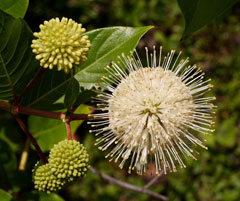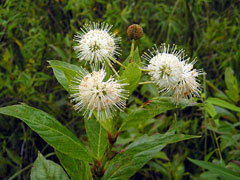 |
|
http://commons.wikimedia.org/wiki/User:Desmodium |
 |
| http://commons.wikimedia.org/wiki/User:Munchkinguy |
Translate this page:
Summary
Bloom Color: White.
Main Bloom Time: Early summer, Early spring, Late summer, Late spring, Mid summer, Mid spring. Form: Rounded.
Physical Characteristics

 Cephalanthus occidentalis is a deciduous Shrub growing to 7 m (23ft).
Cephalanthus occidentalis is a deciduous Shrub growing to 7 m (23ft).
See above for USDA hardiness. It is hardy to UK zone 6. It is in flower in August, and the seeds ripen in October. The species is hermaphrodite (has both male and female organs).
Suitable for: light (sandy), medium (loamy) and heavy (clay) soils. Suitable pH: mildly acid and neutral soils. It can grow in semi-shade (light woodland) or no shade. It prefers moist or wet soil.
UK Hardiness Map
US Hardiness Map
Synonyms
Plant Habitats
Woodland Garden Sunny Edge; Dappled Shade; Shady Edge; Bog Garden;
Edible Uses
References More on Edible Uses
Medicinal Uses
Plants For A Future can not take any responsibility for any adverse effects from the use of plants. Always seek advice from a professional before using a plant medicinally.
Astringent Diaphoretic Diuretic Dysentery Emetic Febrifuge Laxative Malaria
Odontalgic Ophthalmic Tonic
Button bush was often employed medicinally by native North American Indian tribes who used it to treat a range of ailments[257]. It is little used in modern herbalism. A tea made from the bark is astringent, emetic, febrifuge and tonic[61, 222]. A strong decoction has been used to treat diarrhoea and dysentery, stomach complaints, haemorrhages etc[257]. It has been used as a wash for eye inflammations[222]. A decoction of either the roots or the fruits have been used as a laxative to treat constipation[257] The leaves are astringent, diaphoretic, diuretic and tonic[61, 222]. A tea has been used to check menstrual flow and to treat fevers, kidney stones, pleurisy etc[222]. The plant has a folk reputation for relieving malaria[222]. The inner bark has been chewed in the treatment of toothaches[222].
References More on Medicinal Uses
The Bookshop: Edible Plant Books
Our Latest books on Perennial Plants For Food Forests and Permaculture Gardens in paperback or digital formats.

Edible Tropical Plants
Food Forest Plants for Hotter Conditions: 250+ Plants For Tropical Food Forests & Permaculture Gardens.
More

Edible Temperate Plants
Plants for Your Food Forest: 500 Plants for Temperate Food Forests & Permaculture Gardens.
More

More Books
PFAF have eight books available in paperback and digital formats. Browse the shop for more information.
Shop Now
Other Uses
References More on Other Uses
Cultivation details
Landscape Uses:Border, Massing. An easily grown plant[1], it prefers an open position in a moisture retentive or wet neutral to acid humus-rich soil[200]. Dislikes dryness at the roots[11]. A calcifuge plant, it dislikes alkaline soils[200]. Requires a sunny position[184]. Plants are hardy to about -25°c[184]. A fast-growing but short-lived species in the wild[229]. The flowers, and the dried leaves, have a soft sweet fragrance like newly mown hay[245]. A good bee plant[149]. Plants are sometimes evergreen[200]. Special Features:North American native, All or parts of this plant are poisonous, Wetlands plant, Attracts butterflies, Fragrant flowers, Attractive flowers or blooms.
References Carbon Farming Information and Carbon Sequestration Information
Temperature Converter
Type a value in the Celsius field to convert the value to Fahrenheit:
Fahrenheit:
The PFAF Bookshop
Plants For A Future have a number of books available in paperback and digital form. Book titles include Edible Plants, Edible Perennials, Edible Trees,Edible Shrubs, Woodland Gardening, and Temperate Food Forest Plants. Our new book is Food Forest Plants For Hotter Conditions (Tropical and Sub-Tropical).
Shop Now
Plant Propagation
Seed - we have no details on this plant but would suggest sowing the seed as soon as it is ripe in an acid compost in a cold frame. Sow stored seed in late winter in a cold frame. When they are large enough to handle, prick the seedlings out into individual pots and grow them on in a cold frame for at least their first winter. Plant them out into their permanent positions in late spring or early summer, after the last expected frosts. Cuttings of soft or semi-ripe wood, July in a frame[200]. Layering.
Other Names
If available other names are mentioned here
Native Range
NORTHERN AMERICA: Canada (New Brunswick, Nova Scotia, Québec), United States (Connecticut, Indiana, Maine, Massachusetts, New Hampshire, New York, Ohio, Pennsylvania, Rhode Island, Vermont, West Virginia, Illinois, Iowa, Kansas, Minnesota, Missouri, Nebraska, Oklahoma, Wisconsin, Alabama, Arkansas, Florida, Georgia, Kentucky, Maryland, North Carolina, South Carolina, Tennessee, Virginia, Texas), Mexico (Chihuahua, Coahuila de Zaragoza, Durango, Nuevo León, San Luis Potosí, Sinaloa, Sonora, Tamaulipas, Zacatecas, Campeche, Chiapas, Colima, Guerrero, Hidalgo, Jalisco, México, Michoacán de Ocampo, Morelos, Nayarit, Oaxaca, Puebla, Tabasco, Veracruz de Ignacio de la Llave)
Weed Potential
Right plant wrong place. We are currently updating this section.
Please note that a plant may be invasive in one area but may not in your area so it's worth checking.
Conservation Status
IUCN Red List of Threatened Plants Status :

Growth: S = slow M = medium F = fast. Soil: L = light (sandy) M = medium H = heavy (clay). pH: A = acid N = neutral B = basic (alkaline). Shade: F = full shade S = semi-shade N = no shade. Moisture: D = dry M = Moist We = wet Wa = water.
Now available:
Food Forest Plants for Mediterranean Conditions
350+ Perennial Plants For Mediterranean and Drier Food Forests and Permaculture Gardens.
[Paperback and eBook]
This is the third in Plants For A Future's series of plant guides for food forests tailored to
specific climate zones. Following volumes on temperate and tropical ecosystems, this book focuses
on species suited to Mediterranean conditions—regions with hot, dry summers and cool, wet winters,
often facing the added challenge of climate change.
Read More
Expert comment
Author
L.
Botanical References
1143200
Links / References
For a list of references used on this page please go here
Readers comment
| Add a comment |
|
If you have important information about this plant that may help other users please add a comment or link below. Only comments or links that are felt to be directly relevant to a plant will be included. If you think a comment/link or information contained on this page is inaccurate or misleading we would welcome your feedback at [email protected]. If you have questions about a plant please use the Forum on this website as we do not have the resources to answer questions ourselves.
* Please note: the comments by website users are not necessarily those held by PFAF and may give misleading or inaccurate information.
To leave a comment please Register or login here All comments need to be approved so will not appear immediately.
|
Subject : Cephalanthus occidentalis
|
|
|
|